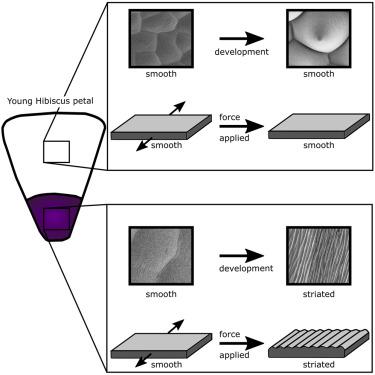Cell Reports ( IF 7.5 ) Pub Date : 2021-09-14 , DOI: 10.1016/j.celrep.2021.109715 Chiara A Airoldi 1 , Carlos A Lugo 1 , Raymond Wightman 2 , Beverley J Glover 1 , Sarah Robinson 2

|
Many species have cuticular striations that play a range of roles, from pollinator attraction to surface wettability. In Hibiscus trionum, the striations span multiple cells at the base of the petal to form a pattern that produces a type of iridescence. It is postulated, using theoretical models, that the pattern of striations could result from mechanical instabilities. By combining the application of mechanical stress with high-resolution imaging, we demonstrate that the cuticle buckles to create a striated pattern. Through mechanical modeling and cryo-SEM fractures, we show that the cuticle behaves like a bilayer system with a stiff film on a compliant substrate. The pattern of buckling aligns with the direction of the stress to create a larger-scale pattern. Our findings contribute to the understanding of the formation of tissue-wide patterns in living organisms.
中文翻译:

机械屈曲可以图案化 Hibiscus trionum 的光衍射角质层
许多物种的角质层条纹发挥着一系列作用,从吸引传粉者到表面润湿性。在芙蓉,条纹跨越花瓣底部的多个细胞,形成一种产生一种虹彩的图案。据推测,使用理论模型,条纹图案可能是由机械不稳定性引起的。通过将机械应力的应用与高分辨率成像相结合,我们证明了角质层弯曲形成条纹图案。通过机械建模和冷冻扫描电镜断裂,我们表明角质层的行为类似于在柔顺基底上具有硬膜的双层系统。屈曲图案与应力方向对齐以创建更大尺度的图案。我们的发现有助于理解活生物体中组织范围模式的形成。











































 京公网安备 11010802027423号
京公网安备 11010802027423号